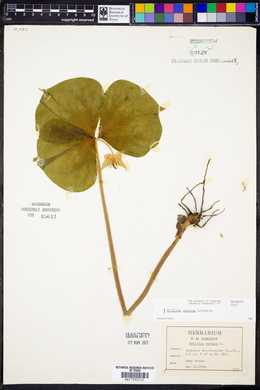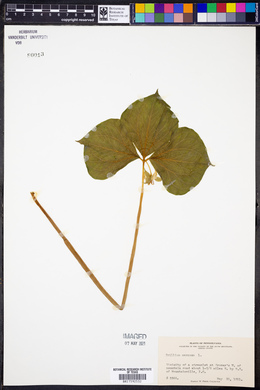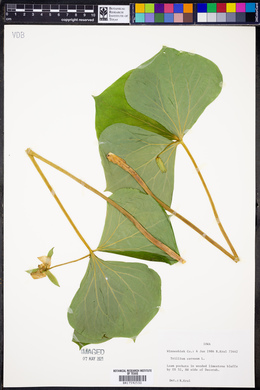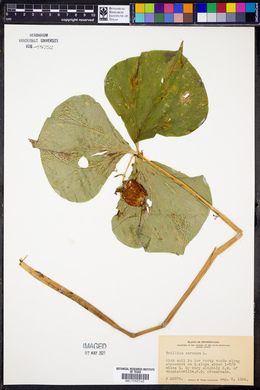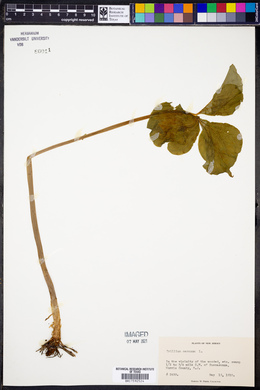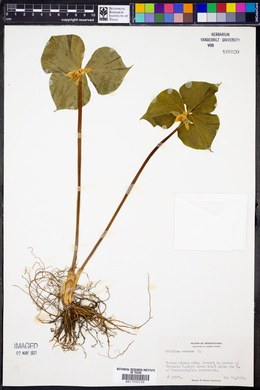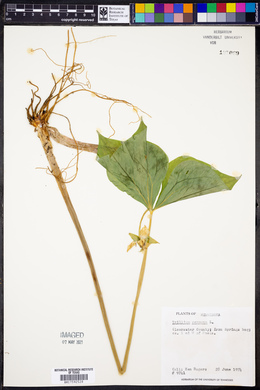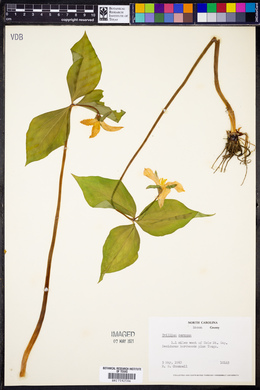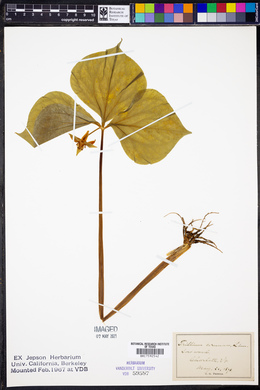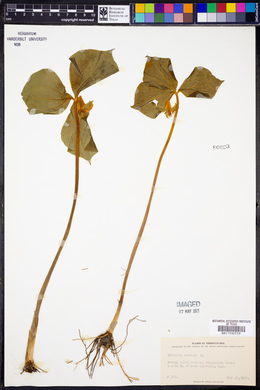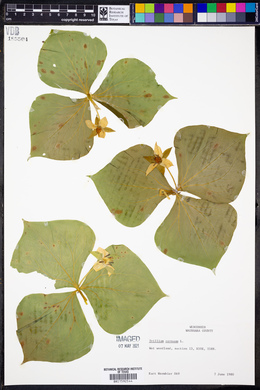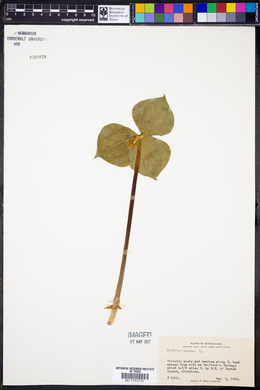Trillium cernuum
|
|
|
|
Family: Melanthiaceae
Whip-Poor-Will-Flower, more...nodding trillium
[Trillium cernuum f. billingtonii Farw., moreTrillium cernuum f. marginatum Cay. & J.Cay., Trillium cernuum f. tangerae Wherry, Trillium cernuum f. viride Cay. & J.Cay.] |
Rhizomes short, thick. Scapes 1-2(-3), round in cross section, 1.5-4+ dm, slender, glabrous. Bracts often overlapping, sessile or with a barely noticeable, petiolelike base, umbrellalike; blade bright green without red tones, broadly rhombic-ovate to suborbicular, 5-15 × 6-15+ cm, base attenuate, apex acuminate. Flower usually hidden beneath bracts, nodding, odorless; sepals spreading, green, lanceolate-ovate, 9-30 mm, slightly shorter than to equaling petals, margins slightly raised, apex acuminate; petals usually strongly recurved from above base, extending behind plane of sepal bases for more than 1/2 their length, white or rarely pale pink, adaxial veins not conspicuous, oblong-lanceolate, 1.5-2.5 × 0.9-1.5 cm, thin-textured, margins entire, apex acuminate; stamens ± straight, 6-15 mm, shorter than pistil, slender; filaments white, ± equaling anthers, slender; anthers straight, pale lavender-pink or -gray, 2-6.5 mm, dehiscence introrse to latrorse; ovary prominent, white to pinkish, pyramidal, strongly 6-angled, 3-12 × 3-10 mm, widest above basal attachment; stigmas erect, recurved, distinct, white, not lobed adaxially, 3-8 mm, widest at base, fleshy, basally thickened, gradually tapered; pedicel strongly recurved or declined below or angled between bracts, 1.5-3 cm. Fruits dark red, with fruity fragrance, ovoid, to 3 cm diam., fleshy, juicy. 2n = 10. Flowering spring--summer (Apr--Jul). Rich, mostly deciduous forest southward, mixed deciduous-coniferous forests, swamps, moist coniferous forests northward; 30--600 m; St. Pierre and Miquelon; Man., N.B., Nfld. and Labr. (Nfld.), N.S., Ont., P.E.I., Que., Sask.; Conn., Del., D.C., Ill., Ind., Iowa, Maine, Md., Mass., Mich., Minn., N.H., N.J., N.Y., N.Dak., Ohio, Pa., R.I., S.Dak., Vt., Va., W.Va., Wis. Previous authors commonly recognized var. cernuum and var. macranthum, based primarily upon size differences. Plants attributed to var. cernuum are found from Delaware and eastern Pennsylvania northward to Newfoundland, while those attributed to var. macranthum are found mainly farther inland into the Midwest. Although there is a tendency for the eastern seaboard plants to be somewhat smaller and more delicate, and the midwestern and far northern plants to be more robust, there is much variation, largely dependent on soil nutrients. There are regional size trends, but based on my observations of this species in Newfoundland, Michigan, Wisconsin, and Minnesota, I do not believe that the two varieties can be maintained. In the Gray Herbarium, there is a collection by Richardson labeled 'Mackenzie River,' which has been cited by H. M. Raup (1947) and others. W. J. Hooker ([1829-]1833-1840) reported Trillium cernuum 'from Saskatchewan to Mackenzie River.' Raup stated that 'it is the only evidence for the occurrence of...Trillium in the entire Mackenzie Basin.' Other writers have simply quoted that statement. In view of the relatively great disjunction from the known Saskatchewan stations and in the absence of any other supporting specimens from that area, I believe that there might be locality error on the Richardson sheet. However, it is not beyond possibility that T. cernuum could occur there. This apparent disjunct station is not mapped here.
Perennial herb with a short, stout rhizome stem 20 - 40 cm tall Flowers: single, nodding, hanging beneath leaves, with six distinct tepals. Flower stalk 1 - 5 cm long, reflexed or recurved. Stamens six, alternating in two whorls of three. Sepals: three, persistent, more or less equal to the petals, lance- to egg-shaped. Petals: three, white (rarely pale pink), 1.5 - 2.5 cm long, 0.9 - 1.5 cm wide, oblong lance-shaped, strongly recurved, shriveling after the flowering period. Fruit: a many-seeded berry, dark red, to 3 mm wide, egg-shaped, fleshy, juicy, with a fruity fragrance. Seeds many, elliptic. Similar species: The stalkless (or nearly stalkless) leaves and horizontal or drooping flowers distinguish this species and Trillium flexipes from all other Trillium species. Trillium flexipes differs by not having strongly recurved flower petals. Flowering: May Habitat and ecology: Very rare in the Chicago Region. Typically found in moist woods. Occurence in the Chicago region: native Notes: Trilliums do not actually have true leaves or stems above the ground. The underground rhizome produces scale-like leaves called cataphylls. The aboveground leaf-like structures are bracts that subtend the flower, but these are internally and externally similar to leaves and function in photosynthesis. Many authors will refer to them as leaves. Etymology: Trillium comes from the Greek word trilix, meaning triple, referring to how all the plant parts occur in threes. Cernuum means nodding. Author: The Morton Arboretum Stem 2-4 dm; lvs broadly rhombic-ovate, 6-10 cm at anthesis, acuminate, narrowed from near the middle to an acute base and obscurely petioled; peduncle 1-5 cm, reflexed or recurved below the lvs; sep lance-acuminate, about equaling the pet; pet normally white, 1.5-2.5 cm; anthers 3-7 mm, a fourth or a third longer than the filaments; ovary white or pinkish; 2n=10. Moist or wet woods in May and June. Var. cernuum, with lance-oblong, usually acute pet 5-10 mm wide, and with anthers 3-5 mm long, occurs from Nf. and Que. to Md., and Del., w. occasionally to Mich. Var. macranthum A. J. Eames & Wiegand, with oblong-oval to obovate, often obtuse pet 10-18 mm wide, and with the anthers 4-7 mm, occurs from Vt. to Minn. and Sask., s. to Md., mainly allopatric with var. cernuum. Gleason, Henry A. & Cronquist, Arthur J. 1991. Manual of vascular plants of northeastern United States and adjacent Canada. lxxv + 910 pp. ©The New York Botanical Garden. All rights reserved. Used by permission. From Flora of Indiana (1940) by Charles C. Deam I found a few specimens in a low, wet woods 8 miles east of Michigan City, La Porte County, and Peattie reports finding it in moist woods near Mineral Springs, Porter County. This variety is northern in its general distribution and in Indiana it is found only in the northern counties. …… Indiana Coefficient of Conservatism: C = 10 Wetland Indicator Status: FAC |







